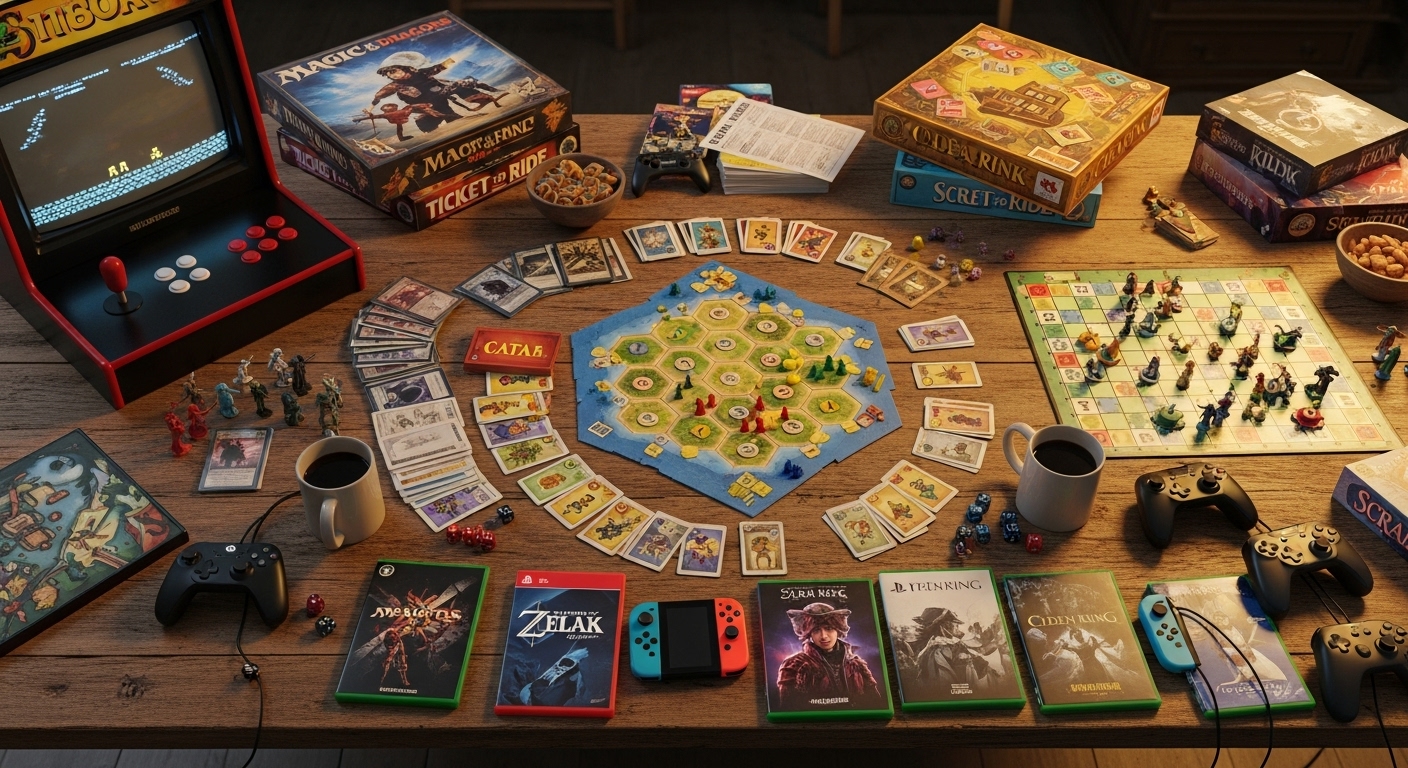Gaming, once a simple pastime, has transformed into one of the most dynamic and influential industries in the world. Over the course of a few decades, video games have evolved from primitive 2D experiences to complex, photorealistic open-world adventures that push the boundaries of creativity, storytelling, and technology. With advancements in hardware, software, and connectivity, the gaming landscape has undergone a dramatic transformation. In this blog post, we will take a deep dive into the history of video gaming, its major milestones, and explore how it has shaped both the entertainment industry and society at large.
The Dawn of Video Gaming: A Simple Start
The story of gaming begins in the early 1950s, a time when computers were used primarily for scientific and military purposes. While the concept of interactive entertainment was hardly at the forefront of technological development, a few visionaries started to experiment with using computers for leisure. The first recognized video game was Tennis for Two, created by physicist William Higinbotham in 1958. This simple tennis simulation, displayed on an oscilloscope, was a modest yet pioneering attempt at creating a digital gaming experience.
However, it was in 1972 that gaming truly began to take form with the release of Pong by Atari. Designed by engineer Nolan Bushnell, Pong was a two-player table tennis game that became the first commercially successful arcade video game. The game’s simplicity, paired with its addictive gameplay, quickly captured the public’s imagination. Arcades began to sprout up, and a new form of entertainment was born. This marked the beginning of a revolution that would change the world of leisure activities forever.
The Rise of the Arcades: Gaming’s Golden Age
The late 1970s and early 1980s are often considered the “Golden Age” of arcade gaming. During this period, the arcade game industry boomed with the release of iconic titles that became household names. Space Invaders (1978), created by Tomohiro Nishikado, was the first true hit of this era, introducing players to a fast-paced shooting game where they had to defend against waves of alien invaders. The game’s success marked the beginning of a string of groundbreaking titles that would define the arcade era, including Pac-Man (1980), Donkey Kong (1981), and Frogger (1981).
What set arcade games apart was their accessibility and the social experience they provided. Arcades became social hubs where people gathered to compete for high scores and enjoy the thrill of gameplay. Gamers would line up to play their favorite games, and a sense of camaraderie emerged as players shared tips, celebrated victories, and challenged each other. The popularity of arcade gaming reached a fever pitch, and the arcade became the focal point of gaming culture.
Unfortunately, the arcade industry began to decline in the mid-1980s, partly due to an oversaturation of low-quality games and a shift in consumer interest toward home gaming. Nevertheless, the impact of this era cannot be overstated. Games like Pac-Man became cultural icons, and the arcade experience set the stage for the next phase of gaming.
The Home Console Revolution: Bringing Gaming to the Living Room
While arcades were in decline, the concept of home gaming was just beginning to take hold. In 1977, Atari released the Atari 2600, one of the first successful home gaming consoles. The Atari 2600 allowed players to enjoy video games from the comfort of their own homes. It was revolutionary, as it brought the arcade experience to living rooms across the world. The console boasted a library of classic titles, including Space Invaders and Pitfall!, which quickly became popular among consumers.
However, the success of home consoles was short-lived. By the early 1980s, the video game market became oversaturated with poorly designed games and faulty hardware. This led to the infamous video game crash of 1983, which saw the collapse of several gaming companies, including Atari. The crash put the video game industry into a state of disarray, and it would take several years before the industry would recover.
The revival came in 1985 when Nintendo released the Nintendo Entertainment System (NES). The NES played a pivotal role in restoring consumer confidence in home gaming and ushered in a new era for video games. It was a well-designed console that featured high-quality games such as Super Mario Bros., The Legend of Zelda, and Metroid. These titles not only showcased the NES’s technical capabilities but also set the stage for more immersive, narrative-driven gaming experiences.
Nintendo’s success helped pave the way for other home console manufacturers. Sega followed with the Sega Genesis (released in 1989), a 16-bit console that provided faster processing speeds and more advanced graphics. The rivalry between Nintendo and Sega defined the gaming landscape throughout the 1990s, with both companies releasing memorable games and consoles that left a lasting impact on the industry.
The 3D Revolution: A New Dimension in Gaming
The 1990s marked a major turning point in gaming with the advent of 3D graphics. While 3D technology had been used in a limited capacity before, it was during this period that games began to embrace the third dimension in a way that forever changed the way players interacted with virtual worlds. One of the first major steps in the 3D revolution came in 1994 with the release of the Sony PlayStation.
The PlayStation was the first major console to use CD-ROM technology, allowing for larger, more detailed games. The PlayStation’s graphical capabilities allowed developers to create fully 3D worlds that players could explore, marking a dramatic shift from the 2D side-scrolling and top-down perspectives that dominated earlier games. Titles like Final Fantasy VII, Gran Turismo, and Crash Bandicoot showcased the power of 3D technology, drawing players into vast virtual environments that were more immersive than anything that had come before.
Around the same time, Nintendo introduced the Nintendo 64, which became known for its groundbreaking 3D platformers like Super Mario 64 and The Legend of Zelda: Ocarina of Time. These games revolutionized the way players navigated and interacted with 3D spaces, setting a new standard for how 3D environments should be designed in games. The 3D revolution not only changed the visual landscape of gaming but also introduced new genres and gameplay mechanics, paving the way for more sophisticated and complex gaming experiences.
The Age of Online Gaming: Connecting Players Across the Globe
The 2000s ushered in the age of online gaming, a development that would forever change the way players interacted with games and each other. With the growth of the internet, gaming went beyond a solitary or local multiplayer experience. The launch of Microsoft’s Xbox in 2001, coupled with its online service Xbox Live, marked the beginning of the online gaming revolution. Xbox Live allowed players to connect to the internet and engage in real-time multiplayer matches with players around the world.
Games like Halo 2 became massive online multiplayer hits, bringing together millions of players for competitive and cooperative gameplay. The popularity of online gaming exploded, and it wasn’t long before other consoles, including Sony’s PlayStation 3 and Nintendo’s Wii, followed suit, offering their own online multiplayer services.
PC gaming also embraced online play, and platforms like Steam revolutionized the way games were purchased and played. Steam allowed users to download games directly to their computers, bypassing traditional retail models and giving indie developers a platform to showcase their games to a global audience. The success of online gaming led to the rise of eSports, where professional gamers compete in tournaments for large cash prizes. Games like League of Legends, Dota 2, and Counter-Strike have become eSports staples, drawing millions of viewers to live-streamed events and creating new career paths for skilled players.
The Modern Era: Photorealism and Immersion
As gaming technology continued to advance, the next big leap in gaming came in the form of photorealism. The PlayStation 4 and Xbox One, released in the mid-2010s, featured powerful hardware capable of rendering games with stunning visual fidelity. Games like The Witcher 3: Wild Hunt, Red Dead Redemption 2, and Horizon Zero Dawn demonstrated the capabilities of modern consoles, showcasing vast open-world environments, dynamic weather systems, and lifelike character models that blurred the line between reality and virtual worlds.
These games featured deep, immersive narratives, along with complex character development and highly detailed worlds. Open-world games became more sophisticated, allowing players to explore massive environments filled with activities, side quests, and hidden secrets. With the advent of high-definition graphics, advanced physics engines, and motion capture technology, the gap between the real world and virtual worlds continued to shrink.
In addition to high-definition graphics, virtual reality (VR) and augmented reality (AR) began to emerge as the next frontier in gaming. VR gaming, in particular, promised to provide players with an unprecedented level of immersion. With the launch of VR headsets like the Oculus Rift, HTC Vive, and PlayStation VR, players could step inside the worlds of their favorite games and experience them in a completely new way. While VR gaming is still in its early stages and faces challenges in terms of accessibility and comfort, it holds significant promise for the future of interactive entertainment.
The Cultural Impact of Gaming
The influence of gaming extends far beyond the realm of entertainment. Video games have become an integral part of modern pop culture, influencing movies, television shows, music, and even fashion. Iconic characters like Mario, Sonic, and Master Chief have become cultural symbols, recognized even by those who don’t consider themselves gamers.
Gaming has also fostered communities, both online and offline, where people can connect over shared interests.




